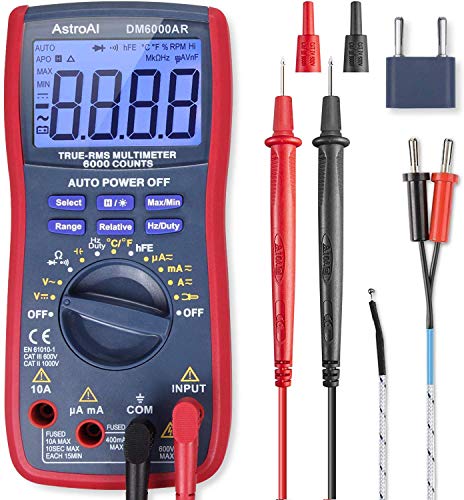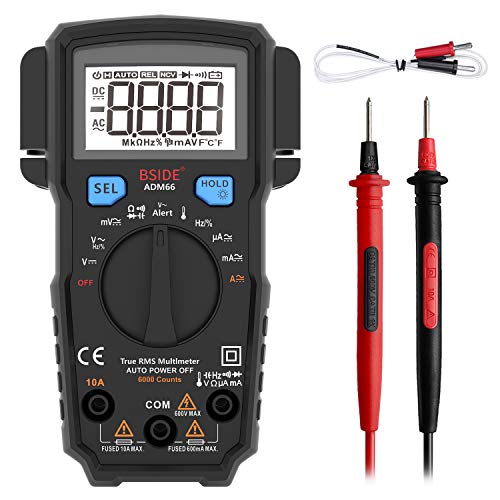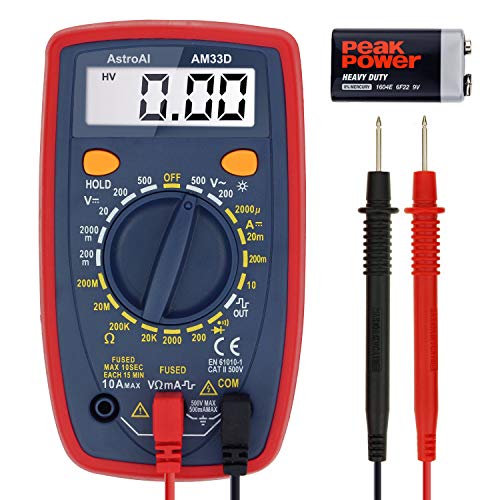A multimeter is an important tool that every home DIYer should have in their kit. They are absolutely necessary for electrical work and provide vital measurements that will help you carry out safe home improvements.
There are lots of multimeters available and the prices range from just a few dollars to hundreds and even over a thousand dollars. Finding the best multimeter doesn’t have to be tiresome, this guide reviews the best multimeters for DIY and the buyer’s guide below gives you some tips on what to look out for.
1. Fluke 117 Electricians True RMS Multimeter (Top Pick)


The Fluke 117 is a high-quality multimeter that has VoltAlert technology for non-contact voltage detection and low input impedance for preventing false readings. This is an accurate, user-friendly tool that will help you get the job done quickly.
This multimeter is able to cope with a wide range of situations and is one of the best multimeters for electricians and amateurs. This model has a large LED backlight for working in poorly lit areas and the battery life is an impressive 400 hours (when used without the backlight).
The Fluke 117 provides min/max/average readings and measures frequency and capacitance. The AutoVolt feature means automatic AC/DC voltage selection. The units small size makes it perfect for use in smaller spaces and it has surge protection too.
What We Like:
- Lots of features
- Backlit display
- Non contact voltage detection
What We Don’t Like:
- No case
2. Fluke 115 Compact True-RMS Digital Multimeter

If you’re looking for a compact and easily-portable multimeter the Fluke 115 is a fantastic option. This unit is accurate, user-friendly and perfect for home use.
The True-RMS feature gives accurate measurement on non-linear loads and the LED backlight is perfect for use in low-light areas. The Fluke 115 works from -10 °C to + 50 °C and it has been independently tested for safe use.
This multimeter can measure frequency, capacitance, continuity and efficiency. It uses a 9V battery and is small enough to fit into your pocket. A useful feature of this model is the data hold option that holds and stores the data until you take a new reading. There is an auto-off feature that shuts the unit down after 15 minutes of inactivity and when it comes to switching batteries the battery access door is easy to open so it takes no time at all.
What We Like:
- Pocket-sized
- Large display
- Accurate readings and data hold option
What We Don’t Like:
- Lack of mA and uA range
3. AstroAI TRMS 6000 Digital Multimeter

The AstroAI TRMS 6000 is a professional level unit that is perfect for commercial use or for weekend DIY. The features and capabilities are slightly more advanced so you are able to measure voltage, current, resistance, continuity, capacitance and frequency and run tests on diodes and transistors too.
This multimeter is packed with convenient, user-friendly features including data hold and auto shut-off. There is a hanging magnet and a kickstand to make positioning the unit and taking measurements easier. The large backlit LCD screen clearly displays all the information you need.
You can also temperature test objects with this multimeter. This is a true RMS multimeter, it is durable and can handle all home requirements with ease while also being heavy duty enough for commercial uses too.
What We Like:
- Good value
- Lots of features
- Sturdy build
What We Don’t Like:
- Some users may find the beeping sound of this unit annoying as it cannot be disabled
4. BSIDE True RMS 6000 Pocket Digital Multimeter

This pocket-sized digital multimeter offers multiple functions including measuring temperature, capacitance, diode, continuity, non-contact AC voltage, Hz, duty cycle, AC/DC voltage current, and more.
The model has a dual probe holder so the probs can be fixed to the holder for measuring or can be stored away for safe carrying. The probes themselves are double insulated and conform to CAT III 600V safety standards.
For double safety protection, this unit has 2 fused fuses. It comes in a sturdy case that provides protection against shocks, friction, and bumps. This case can be removed, washed, and replaced as needed. This BSIDE multimeter also has a kickstand which makes it great for desktop use and easily reading the measurements.
What We Like:
- Portable size
- Protective case and useful kickstand
- Multiple functions
What We Don’t Like:
- Battery not included
5. Fluke 17B+ Auto Range Digital Probe Multimeter

The Fluke 17B+ is an improved model that is durable, reliable and faster than its predecessor. It includes the common basic measurement features of temperature, frequency and duty cycle.
This is an easy to use multimeter than can be operated using one hand. It includes 600 V Cat III safety design specifications and has an overvoltage indicator.
You can perform diode tests and run voltage, resistance, current and capacitance checks. The display has a bright white backlight which clearly shows the reading in light or dark conditions. The data retention feature is very handy if you can’t write down the measurement immediately, you can simply press hold and it will stay on the display until you take another reading.
What We Like:
- User-friendly
- Safe and reliable
- Data retention
What We Don’t Like:
- More expensive than similar products
6. Klein Tools MM400 Multimeter

The MM400 Multimeter comes with everything you need to start testing electrical items. It comes with test leads, thermocouple with adapter and batteries.
This is an auto-ranging multimeter that measures AC/DC voltage, current and resistance. It can also be used to measure temperature, frequency, duty-capacity, capacitance and to test diodes and continuity. The MM400 is a sturdy model that has been built to cope with daily wear and tear and is also able to withstand a 1m drop.
There is a low battery indicator so you won’t be caught unaware. This is a great option that is best for use in residential and light-industrial locations.
What We Like:
- Full kit
- Auto-ranging
- Durable
What We Don’t Like:
- No true RMS accuracy
7. Fluke 101 pocket-sized Multi-meter

The Fluke 101 is a small, compact multimeter that is best for taking standard measurements during home DIY projects. It is great for everyday use and for handling those quicker, smaller projects.
This auto-ranging unit provides reliable measurements and offers DC volts accuracy of 0.5%. It is CAT III 600V safety rated and is small and light enough to use one-handed.
The Fluke 101 may be pocket-sized but it is durable and robust enough to withstand frequent use too. The unit automatically turns off after a period of inactivity to prevent the battery life running down. Fortunately, the battery is easy to replace when needed though.
What We Like:
- Compact
- Best suited to smaller at-home jobs
- Rugged design
What We Don’t Like:
- The display is not backlit
8. AstroAI Digital Multimeter with Ohm Volt Amp

The AstroAI AM33D is one of the best multimeters for troubleshooting automotive and household electrical issues. It is an accurate, safe and easy to use multimeter that offers a range of functions.
You can accurately measure voltage, DC current, resistance, diode, continuity and more with this digital multimeter. The large display is backlit so you can see the readings in dimly lit areas, there is a kickstand for hand-free use and the data hold function keeps the reading on the screen so you have time to write it down.
This digital multimeter is a great option for diagnosing, assembling or repairing circuitry and wiring. The AM33D has a low battery indicator, continuity buzzer and overload protection too.
What We Like:
- Backlit display
- Low battery indicator
- Best for household use
What We Don’t Like:
- Lacks features – only measures DC current
9. XL830L Digital Multimeter Ohmmeter

These low-cost digital multimeters can be used to measure AC and DC voltage and current, resistance, diode, frequency, capacitance and temperature. You can also test continuity and there is a buzzer sound in the circuit which is very useful. This is a great budget option for carrying out simple home DIY projects.
The small and compact design makes this model easily portable. The rotary control switch allows you to change between electrical values and ranges and it works accurately and reliably.
The LCD display has a backlight option and is clear and easy to read. There is a handy low battery indicator on the screen too.
What We Like:
- Low cost
- Great for home use
- Easy to use
What We Don’t Like:
- The backlight turns off automatically after a short period of time which can be frustrating for longer jobs being carried out in low light
Multimeter Buyers’ Guide
A multimeter is a handheld tool that is used by electricians and other types of technicians to measure and test various electrical components. It is a great tool for people carrying out DIY work and hobbyists too. There are lots of different multimeters on the market so this buyer’s guide is a quick and easy way to narrow down the choice to find the best multimeter for your uses.
Analog vs Digital
This is one of the first decisions you will need to make when choosing a multimeter as they are available in analog or digital form. Digital multimeters are more popular but some people do prefer the clarity of an analog display. Some electricians feel it is easier to see the trends and real-time changes with an analog multimeter but they have a lower input impedance and are usually more limited in what they can measure compared to a digital option. Generally, the best options are digital multimeters as they are much more versatile and efficient.
If you’re not sure whether the multimeter you are considering is digital or analog it is simple to tell the difference as a digital multimeter has a small screen to display the reading while an analog multimeter has a needle that moves along a scale.
RELATED:
Auto or Manual Ranging
- An auto ranging digital multimeter has the ability to recognise what is being tested and will display the desired measurement. Choosing an auto-ranging option can save you time and means you can use the multimeter without knowing all the ins and outs of how it works.
- Manual ranging multimeters feature preset ranges and you will need to know the range of values the component comes under in order to be able to get a reading.
Key Features
If you have a clear idea of what you will need to measure and test it will be easier for you to choose between different multimeters but if you are looking for a good all-rounder keep in mind the following features:
Versatility
Basic multimeters are generally able to measure AC current, DC current, voltage, resistance and capacitance. The best electrical multimeter options offer a wider variety of measurements and tests including diode, continuity, battery and transistor tests as well as functions such as auto range, true RMS and an analog bar graph. The functions are important to consider, make sure the multimeter you choose is able to produce accurate measurements and tests in the areas you require them.
Design & Build
Most multimeters come in a sturdy casing and are brightly coloured to prevent accidents. The build needs to be of high quality to withstand regular use. The majority of multimeters can be held comfortably in one hand and some come with a magnetic hook or a kickstand to make it easier for you to carry out the measurements and tests.
RELATED:
Accuracy
The accuracy of the multimeter is the largest allowable error under specific conditions, what is considered acceptable will generally vary depending on the situation. As a broad guideline, +/- 2% is fine for home hobby uses. In professional situations, the best multimeters are going to be the more accurate ones but these will also come at a higher cost.
Safety Features
The majority of multimeters have a warning feature where they will beep or buzz if the leads are plugged in incorrectly for the settings that are being used. This helps prevent a short circuit from occurring by incorrectly using the multimeter. Always check the multimeters maximum voltage and current ratings to make sure it can handle what you need to use it for.
